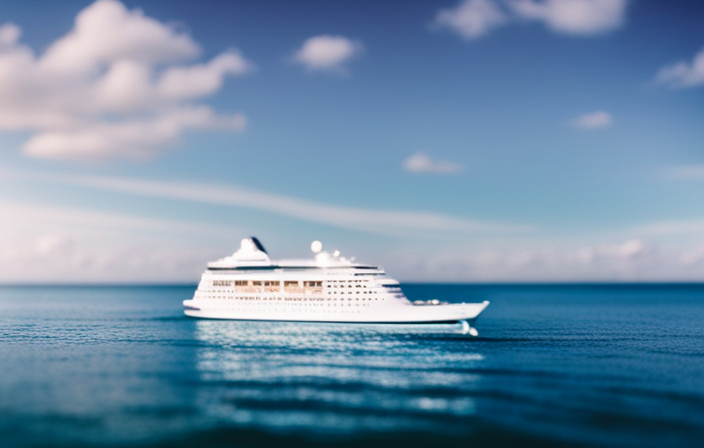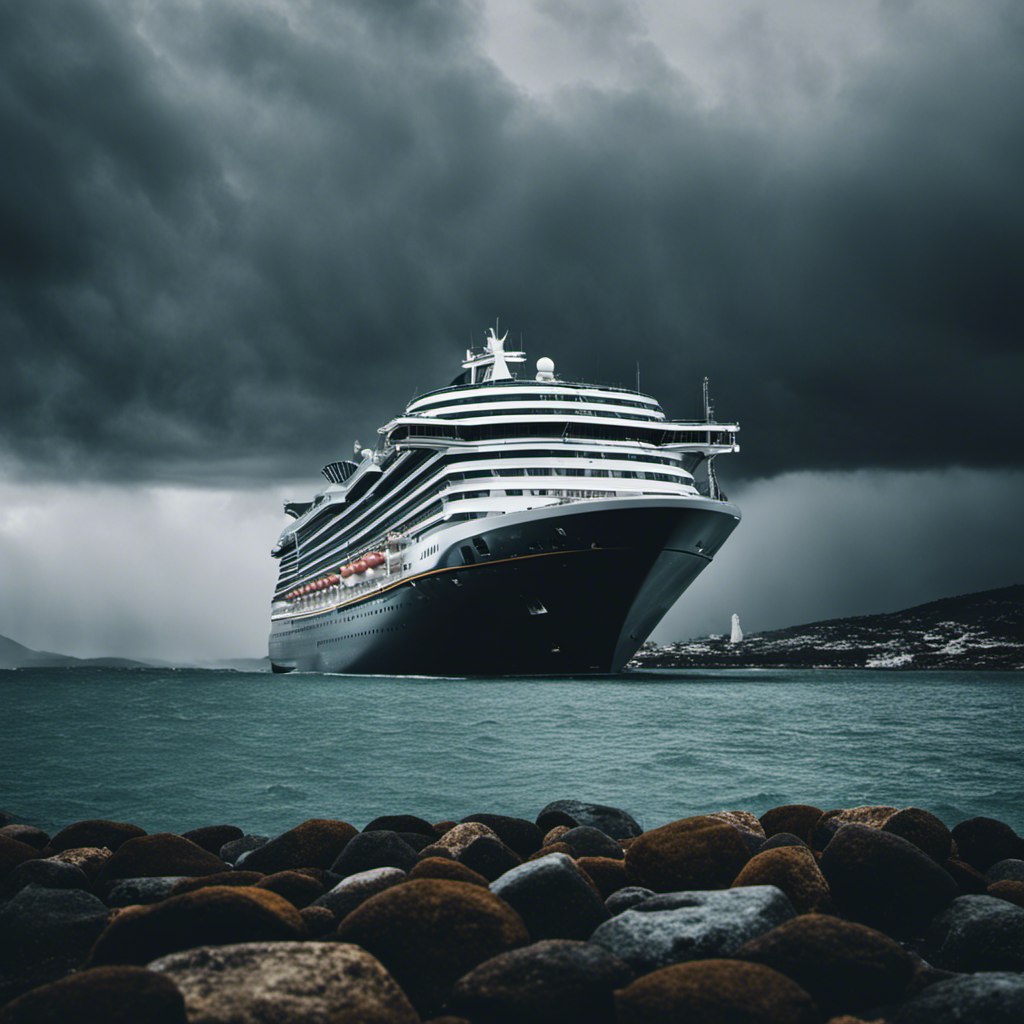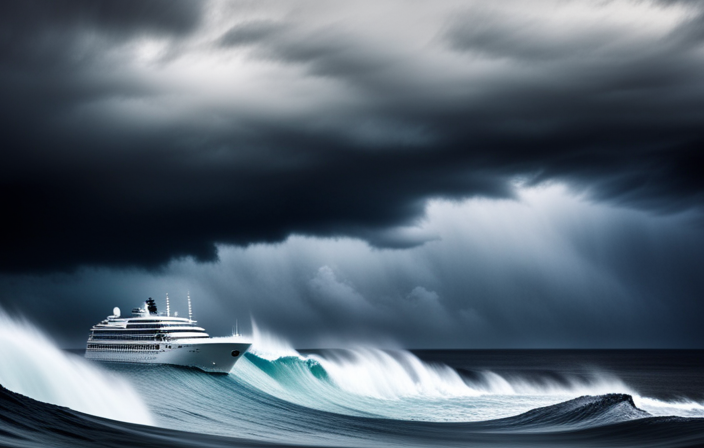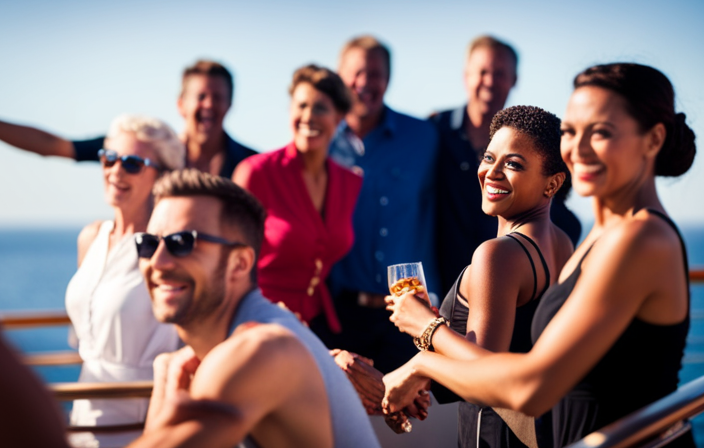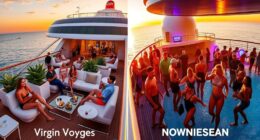The saying ‘Smooth seas do not make skilled sailors’ holds particularly true in understanding the draft of a cruise ship.
Hi there, I’m here to take you on a journey through the fascinating world of cruise ship draft.
So, what exactly is draft? Well, in simple terms, it refers to the distance between a cruise ship’s waterline and the deepest point of its hull. But don’t let its simplicity fool you, because draft plays a crucial role in a ship’s stability, navigating different ports, and even shaping cruise itineraries.
In this article, we’ll delve into the factors that determine a cruise ship’s draft, explore the importance of draft for safe navigation, and discuss the latest technologies and innovations that improve draft management.
So, fasten your seatbelts and get ready to dive into the depths of cruise ship draft.
Key Takeaways
- Draft management is essential for the safe operation of cruise ships, including avoiding potential hazards in shallow waters or underwater obstacles.
- Technology and innovations, such as advanced sensors and real-time data analysis, are used for draft monitoring and optimization to enhance safety and efficiency.
- The draft of a cruise ship plays a crucial role in determining its environmental impact, and regulations and innovative technologies are in place to reduce carbon footprint and minimize negative effects on marine ecosystems.
- Draft management enables cruise ships to navigate in various water depths, including shallow ports and sensitive areas, while balancing efficient operations with environmental sustainability.
Definition of Draft in the Context of Cruise Ships
The draft refers to the vertical distance between the waterline and the deepest part of the ship’s hull. It is a crucial measurement for determining a ship’s stability and maneuverability.
Draft limitations are guidelines that cruise ships must adhere to in order to safely navigate various ports and waterways. Different ports have different depth restrictions, so cruise ships must optimize their draft to ensure they can access these destinations. This involves adjusting the ship’s cargo load and fuel levels to maintain a safe draft.
Draft optimization is essential for maximizing a ship’s efficiency and minimizing fuel consumption. Understanding how draft affects a cruise ship’s stability is vital for ensuring a smooth and safe sailing experience for passengers.
How Draft Affects a Cruise Ship’s Stability
To better understand how draft affects a cruise ship’s stability, let’s break it down into a few key points.
Firstly, the draft of a ship refers to the distance between the waterline and the lowest point of the ship’s hull. This measurement is crucial because it determines how deep the ship sits in the water.
When the draft is too shallow, the ship becomes more susceptible to tipping over by waves. This poses a significant safety risk for both passengers and crew members.
Conversely, if the draft is too deep, the ship may encounter difficulties navigating in shallow waters. This can limit the ship’s access to certain ports and destinations.
The impact of wave height on stability is also a crucial factor to consider. Higher waves can cause the ship to pitch and roll more, which can affect the overall stability of the vessel.
To manage the draft and ensure stability, cruise ships utilize ballast tanks. These tanks can be filled with water or emptied to adjust the ship’s weight distribution. This allows the ship to maintain balance in varying sea conditions.
Overall, the draft of a cruise ship plays a vital role in determining its stability. By carefully managing the ship’s weight distribution and considering factors such as wave height, cruise lines can ensure the safety and comfort of their passengers.
Factors That Determine a Cruise Ship’s Draft
One crucial factor that determines the depth a cruise ship can safely navigate is the overall size of the vessel.
However, there are several other factors that can affect a cruise ship’s draft.
These factors include the weight of the ship, the distribution of the weight, and the shape of the hull.
The weight of the ship is important because it determines how much water the ship displaces, which directly affects the draft.
Additionally, the distribution of the weight on the ship can also impact the draft. If the weight is unevenly distributed, it can cause the ship to list to one side, affecting its stability.
The shape of the ship’s hull also plays a role in determining the draft. A deeper hull will result in a greater draft.
These factors affecting draft have a direct impact on the ship’s performance, including its maneuverability and stability in the water. They are crucial considerations for ship designers and operators.
Moving forward, understanding the importance of draft for navigating different ports is essential to ensure safe and efficient travel.
The Importance of Draft for Navigating Different Ports
Discover how understanding the depth requirements of various ports can enhance your cruising experience and ensure seamless navigation.
The importance of draft in shipbuilding cannot be overstated. Draft refers to the depth of a ship’s hull below the waterline, and it plays a crucial role in determining a ship’s maneuverability.
Different ports have different depth restrictions, and having knowledge of these restrictions is vital for cruise ship captains and navigators. A ship with a shallow draft can easily navigate ports with shallow waters, allowing for access to a wider range of destinations.
On the other hand, a ship with a deep draft may face limitations in terms of which ports it can visit. Understanding the impact of draft on ship maneuverability is essential for planning cruise itineraries and ensuring that passengers can explore a variety of ports.
This knowledge allows cruise lines to offer diverse and exciting destinations for their guests, creating unforgettable experiences.
Transitioning into the next section, let’s explore the impact of draft restrictions on cruise itineraries and the challenges they present.
Draft Restrictions and Their Impact on Cruise Itineraries
Navigating through restricted waters can be frustrating and limiting for cruise itineraries. It can cause missed opportunities and dashed hopes for new adventures. Draft restrictions play a significant role in determining the routes cruise ships can take and the ports they can visit.
These restrictions are imposed to ensure the safety of the vessel and prevent damage to the environment. Cruise itineraries often have to be adjusted due to draft restrictions, resulting in changes to the planned destinations and activities. Passengers may miss out on exploring certain ports or participating in specific excursions.
However, cruise lines work diligently to offer alternative experiences and make the most of the situation. They understand the importance of providing passengers with enjoyable and memorable trips, even when faced with draft restrictions.
Understanding draft restrictions and their impact on cruise itineraries is essential for both passengers and cruise operators. It allows them to plan accordingly and manage expectations. Additionally, these restrictions also influence the ship’s overall performance and operational considerations, which will be discussed in the subsequent section about draft and fuel efficiency in cruise ship operations.
Draft and Fuel Efficiency in Cruise Ship Operations
Immerse yourself in the world of cruise ship operations and uncover the hidden currents of fuel efficiency, a vital element that propels these magnificent floating cities towards their destinations.
Fuel consumption plays a crucial role in the operational efficiency of cruise ships. With their massive size and constant movement, cruise ships require a significant amount of fuel to power their engines and provide electricity for various onboard facilities.
However, cruise lines have been striving to improve their fuel efficiency by implementing innovative technologies and practices. These include using advanced propulsion systems, optimizing routes, and employing energy-saving measures such as LED lighting and waste heat recovery systems.
By reducing fuel consumption, cruise ships not only contribute to environmental sustainability but also enhance their operational efficiency and cost-effectiveness.
As we explore further into the realm of cruise ship operations, we will delve into the draft and safety considerations for these vessels, ensuring a comprehensive understanding of their intricate workings.
Draft and Safety Considerations for Cruise Ships
Ensuring the safety of passengers and crew members is of paramount importance in the intricate workings of these floating cities. Draft plays a crucial role in the safety considerations for cruise ships. Draft regulations are in place to ensure that cruise ships maintain a safe distance from the ocean floor, avoiding potential hazards such as shallow waters or underwater obstacles. Regular draft maintenance is essential to keep the ship’s draft within the acceptable limits set by these regulations. This includes periodic inspections and maintenance of the ship’s hull, propellers, and other underwater components. To evoke an emotional response, consider the following table:
| Category | Safety Considerations |
|---|---|
| Structural Integrity | Ensuring the ship’s hull is strong and free from damage. |
| Stability | Maintaining the ship’s stability through proper ballasting and load distribution. |
| Emergency Preparedness | Equipping the ship with life-saving equipment and conducting regular drills. |
| Navigation | Properly training the crew to navigate safely and efficiently. |
Technology and innovations to improve draft management will be discussed in the subsequent section, exploring how cruise ships utilize advanced systems to enhance safety and efficiency.
Technology and Innovations to Improve Draft Management
With cutting-edge technology and innovative solutions, you’ll discover a whole new level of safety and efficiency in managing the depth of your floating haven. Here are three ways technology and innovation are revolutionizing draft management on cruise ships:
-
Draft monitoring systems: Advanced sensors and real-time data analysis allow for continuous monitoring of the ship’s draft. This enables early detection of any changes in the depth, ensuring timely adjustments to maintain optimal draft levels.
-
Draft optimization algorithms: Utilizing sophisticated algorithms, cruise ships can optimize their draft to minimize fuel consumption and increase efficiency. By adjusting ballast and cargo distribution, ships can achieve the ideal balance between stability and draft.
-
Automated draft control systems: Automation plays a crucial role in draft management. Automated systems can make real-time adjustments to ballast tanks, ensuring the ship maintains the desired draft even in changing conditions.
These technological advancements in draft monitoring and optimization contribute to enhanced safety and efficiency on cruise ships. As we delve into the environmental impacts of cruise ship draft, it becomes evident how these innovations are transforming the industry.
Environmental Impacts of Cruise Ship Draft
One cannot ignore the significant environmental consequences brought about by the depth at which cruise ships navigate the waters. The draft of a cruise ship plays a crucial role in determining its impact on the environment. Environmental regulations have been implemented to address the concerns associated with cruise ship draft. These regulations aim to reduce the carbon footprint of these vessels and minimize their negative effects on marine ecosystems. Cruise ship companies are now investing in innovative technologies to improve draft management and comply with these regulations. For example, some ships are utilizing advanced propulsion systems and hull designs to optimize fuel efficiency and reduce emissions. Additionally, the use of alternative fuels and the implementation of waste management systems have also contributed to minimizing the environmental impacts of cruise ship draft. Transitioning into the conclusion, it is clear that draft management is a fascinating aspect of the cruise ship industry.
Conclusion: The Fascinating Role of Draft in the World of Cruise Ships
Conclusion: The Fascinating Role of Draft in the World of Cruise Ships
In the captivating world of cruise ships, the intricate management of draft unveils a mesmerizing interplay between engineering, environmental consciousness, and technological innovation.
Draft management plays a crucial role in ensuring the safe operation of cruise ships. It refers to the measurement of the vertical distance between the waterline and the lowest part of the ship’s hull. Cruise ships must adhere to draft regulations set by international maritime organizations to maintain stability, maneuverability, and safety.
These regulations take into account factors such as the ship’s size, weight, and the depth of water in which it operates. By carefully managing the draft, cruise ships can navigate various water depths, including shallow ports or environmentally sensitive areas.
The fascinating world of draft in cruise ships demonstrates the industry’s commitment to balancing efficient operations with environmental sustainability.
Frequently Asked Questions
How does the draft of a cruise ship impact the ship’s speed and maneuverability?
The draft of a cruise ship significantly impacts its speed and maneuverability. A deeper draft means more stability but lower fuel efficiency, while a shallower draft allows for higher speed but less stability.
Are there any limitations or regulations on the maximum draft allowed for cruise ships?
There are limitations and regulations on the maximum draft allowed for cruise ships. These restrictions ensure that ships can safely navigate in different ports and waterways. They take into account factors such as tides, bridge heights, and depth of water.
What measures are taken to ensure the safety of passengers and crew in relation to the draft of a cruise ship?
To ensure the safety of passengers and crew, cruise ships implement various safety measures. These include regular inspections, emergency drills, and the use of advanced technology. Additionally, environmental impacts are minimized through waste management and pollution control systems.
Can the draft of a cruise ship be adjusted or modified depending on the specific needs of a port or itinerary?
Yes, the draft of a cruise ship can be adjusted or modified to meet the specific needs of a port or itinerary. This is done to comply with port restrictions and ensure the ship can safely navigate in shallower waters.
Are there any ongoing research or development efforts to further improve draft management and reduce environmental impacts of cruise ships?
Yes, ongoing research efforts are focused on improving draft management and reducing environmental impacts of cruise ships. These efforts aim to develop innovative technologies and practices that promote sustainability and minimize the ecological footprint of the industry.
How does the location of a cruise ship’s construction impact its draft?
The cruise ship construction locations play a significant role in determining the draft of a ship. The depth of the water at the construction site directly affects the ship’s design, as it must be able to navigate safely in shallow and deep waters. The location also influences the ship’s stability, as different sea conditions factor into the construction process.
Conclusion
In conclusion, the draft of a cruise ship plays a crucial role in its stability and maneuverability.
It is the measurement of the distance between the waterline and the deepest point of the ship.
Understanding the factors that determine draft, such as the ship’s design, load, and ballast, is essential for safe navigation and port accessibility.
Draft restrictions can impact cruise itineraries, but advancements in technology are helping to improve draft management.
However, we must also consider the environmental impact of cruise ship draft.
As the saying goes, ‘Every drop in the ocean counts,’ so it is vital to continue finding ways to minimize our ecological footprint in the fascinating world of cruise ships.

